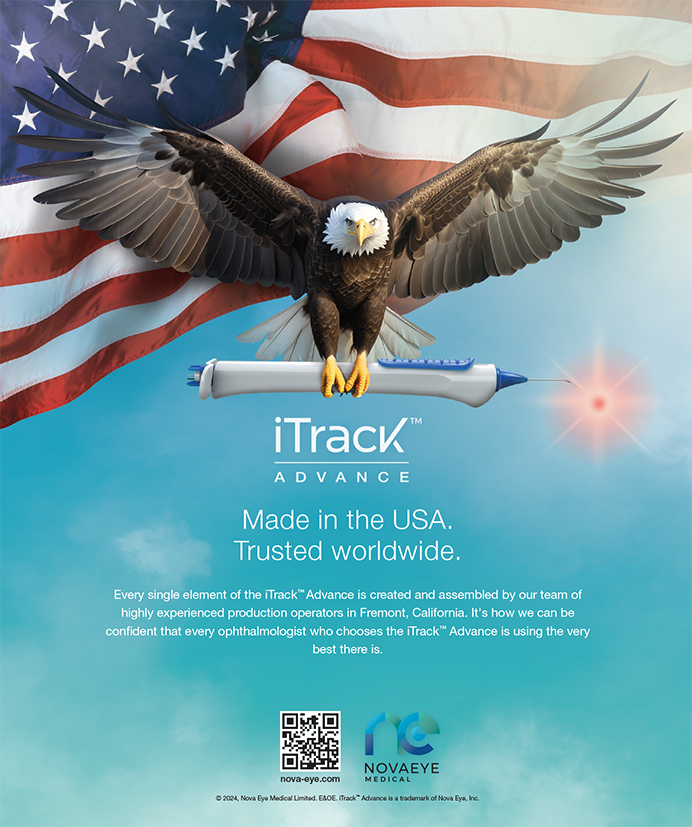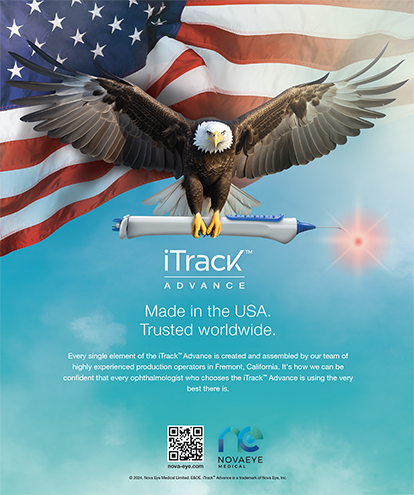There are three requirements for performing wavefront-guided ablation: the ability to measure the wavefront, the capability of the laser platform to treat the wavefront, and the ability to ensure that the treatment occurs exactly where the wavefront was measured. The LADARVision System for CustomCornea (Alcon Laboratories, Inc., Fort Worth, TX) fulfills these requirements.
MEASURING THE WAVEFRONT
The LADARWave, LADARVision's aberrometer, uses an enhanced Hartmann-Shack–based system that measures more than 210 points over a 7-mm pupil. The LADARWave can measure from -14.00 D to +8.00 D with as much as 6.00 D of astigmatism, and its large, instantaneous, dynamic range eliminates the need for compensation lenses. The resolution (number) of the lenslets allows it to measure up to eighth-order aberrations so that it can measure even highly aberrated or keratoconic eyes.
The LADARWave's automatic fogging feature addresses the wavefront changes that occur with accommodation. As the individual relaxes accommodation and the wavefront pattern ceases to change, the system takes a series of five wavefront measurements and uses the three that are most similar to create a composite wavefront. The system's software transforms this composite into a treatment ablation.
By optimizing the instrument's lenslet array pattern and design, Alcon minimized the problem of crossover effects, which can occur with any Hartmann-Shack–based system and can produce inaccurate measurements. Additionally, the system's display allows the surgeon to look at the wavefront two- and three-dimensionally and to analyze aberrations individually. This capability facilitates diagnosing the cause of pre- and post-LASIK visual symptoms.
TREATING THE WAVEFRONT
Wavefront-Driven Ablations
We need to know how a given excimer laser platform really uses the wavefront data to drive the treatment ablation. Certainly, the surgeon may want to adjust the wavefront-generated ablation profile. (Alcon's system compensates for the predictable biomechanical effects involved in creating a flap with a microkeratome and in that flap's healing response.) Using an aberrometer to measure sphere and cylinder for an exceptionally accurate refraction does not constitute customized ablation, nor does this approach account for other higher-order aberrations.
It certainly remains the prerogative of a company to have a system treat only limited aspects of the wavefront; that choice could even be desirable. The more we know about a laser system and the targeted end result, however, the better equipped we will be to use it appropriately. CustomCornea applies an algorithm to the wavefront data generated in order to create the ablation profile that drives the treatment. It attempts to treat all pre-existing aberrations and prevent the induction of new aberrations.
Beam Profile and Pulse Placement
Customized LASIK involves complex ablations of small amounts of corneal tissue by means of precisely placed laser pulses. To fulfill this requirement, LADARVision employs an 0.8-mm Gaussian flying spot laser that runs at 60 Hz. A true Gaussian beam should produce a smoother ablation profile than a top hat-type profile such as the one used by the Zyoptix system (Bausch & Lomb Surgical, San Dimas, CA). The reason is that the shoulders of the Gaussian beam slope somewhat, whereas a top-hat beam has sharp shoulders.
The LADARVision4000 places the laser pulses nonsequentially so that they do not overlap until the fifth pulse. A pulse causes the corneal tissue to tighten somewhat as a result of local, thermal effects. The tissue may respond differently to the next pulse of laser energy, depending on how much it has relaxed. Nonsequential placement of pulses, so that they do not immediately overlap, allows the tissue to relax before the next pulse strikes that area, and it produces a more predictable ablative response with each pulse.
Tracking
While every other excimer laser platform uses a video-based or infrared tracking system, the LADARVision4000 employs a closed-loop laser radar tracking system. Four diode lasers functioning at 905 nm center themselves over the pupillary margin at four discrete positions (eg, the 10:30-, 1:30-, 4:30-, and 7:30-o'clock positions). Each laser directs pulses of diode laser energy 4,000 times per second (referred to as the sampling rate) toward the pupillary margin. The iris reflects half of the energy toward the tracker, and half of the energy enters the pupil, where it is lost. If the eye moves upward, downward, right, or left, the return signal from each tracking diode laser will change. The system can calculate how much the eye moved based on the changes in the relative return signals, and it compensates for the eye's movement.
Some might argue, incorrectly, that sampling is unimportant, because the response time of most tracking mirrors is 10 milliseconds and they can only move 100 times per second. Sampling rates are important; they determine how quickly the system initially recognizes ocular movement. The eye can only move for 1/4,000 of a second before the LADARVision4000 realizes it. The system then starts moving its tracking mirrors to reposition the ablation. By contrast, the best video-based tracking system is 250 to 300 Hz. The Zyoptix system's pulse sampling rate is 120 Hz, so an eye can move 30 times more often or farther, when compared with a LADARVision eye, before the Zyoptix system recognizes the movement and starts to move its tracking mirrors.
ALIGNING THE WAVEFRONT AND ABLATION
Registration links the wavefront measurement to the ablation treatment. For the best outcomes, we must apply each pulse of laser energy as intended. Alcon's eye tracker ensures that treatment occurs properly at each point on the cornea, but only once we tell the system where to put the treatment. LADARWave is presently the only wavefront system with true registration capabilities.
While the patient is upright, the surgeon uses a surgical marking pen to place two marks at the edge of the limbus, usually at the 3- and 9-o'clock positions. He then dilates the patient, a critical step. The only way to measure aberrations in the periphery is to dilate the pupil; otherwise, the treatment will be based on a limited—and potentially inaccurate—representation of the eye's aberrations.
Once the patient is dilated and positioned in front of the LADARWave device, the surgeon places a horizontal axis line through the two limbal ink marks and measures the wavefront. Next, the staff positions the patient underneath the LADARVision4000 excimer laser for treatment. There is no need to wait, because this system can track a dilated pupil. The eye tracker locks in the eye in terms of the x- and y-axes. By aligning the horizontal axis line with the two limbal markings, the surgeon compensates for cyclotorsion and ensures that the eye is in the same position as when the wavefront measurement was taken. This is more than simply discerning that cyclotorsion has occurred; it actually compensates for the cyclotorsion.
Registration is critical to successful wavefront-guided ablation outcomes. For example, if the treatment is misregistered by 10º of cyclotorsion, there will be a 30% loss of astigmatic-corrective effect, a 50% loss of trefoil correction, and a 65% loss of tetrafoil correction. Translational errors in registration result in similarly poor outcomes.
PERSONAL EXPERIENCE
FDA clinical trial results showed that the LADARVision System for CustomCornea provided superior optical quality over conventional ablation and dramatically reduced the induction of higher-order aberrations.1 Since sharing its results with the FDA, Alcon has improved its algorithm and further reduced the amount of spherical aberration the system induces from 11% to 1%. A recent study included 36 eyes with sphere of up to -5.25 D, cylinder of up to -2.50 D, and a mean spherical equivalent of -2.94 D. Ninety-two percent of astigmatic eyes and 100% of spherical eyes achieved 20/20 UCVA, and 75% of astigmatic eyes and 87% of spherical eyes had a UCVA of 20/16 at 3 months postoperatively.2
I have used LADARVision to perform customized ablation on more than 300 eyes (primary treatments, retreatments, and treatments of symptomatic postsurgical eyes). My results have been excellent. The FDA's first approval of this customized ablation system provides us with a solid platform on which to build.
Omar J. Hakim, MD, FRCSC, is Medical Director for TLC Laser Eye Centers in Canada. He is a consultant for Alcon Laboratories, Inc. Dr. Hakim may be reached at (416) 733-2020; ojhakim@aol.com.
1. US Food and Drug Administration, Center for Devices and Radiological Health. LASIK eye surgery: FDA-approved lasers for LASIK. Available at: http://www.fda.gov/cdrh/lasik/lasers.htm. Accessed January 2, 2003.
2. Brint SF, Hakim OJ, Durrie DS, et al. Wavefront-guided myopic LASIK with Custom Cornea. Paper presented at: Twentieth Congress of the European Society of Cataract and Refractive Surgeons; September 10, 2002; Nice, France.


